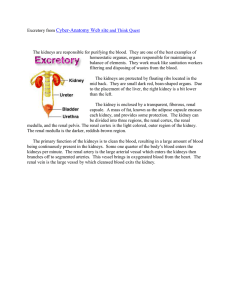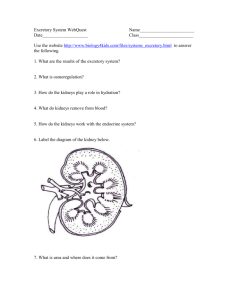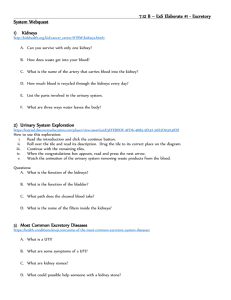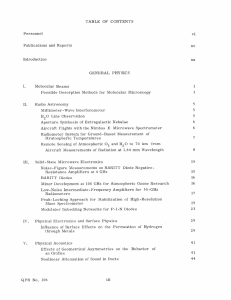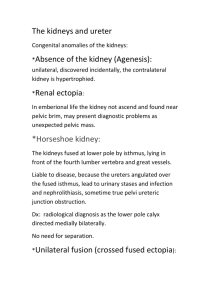X. COMMUNICATIONS BIOPHYSICS Academic and Research Staff
advertisement
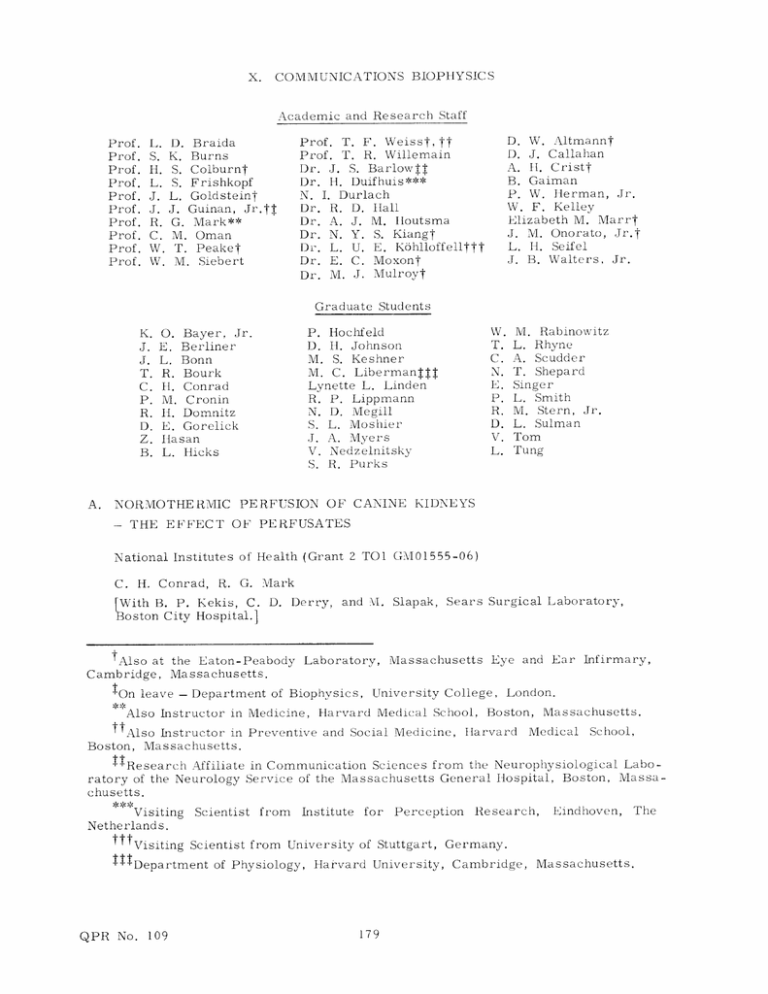
X. COMMUNICATIONS BIOPHYSICS Academic and Research Staff Prof. Prof. Prof. Prof. Prof. Prof. Prof. Prof. Prof. Prof. D. W. Altmannt D. J. Callahan A. HI. Cristt B. Gaiman P. W. Herman, Jr. W. F. Kelley Elizabeth M. Marrt J. M. Onorato, Jr.t L. H. Seifel J. B. Walters, Jr. Prof. T. F. Weisst, tt Prof. T. R. Willemain Dr. J. S. Barlowjf Dr. H. Duifhuis*** N. I. Durlach Dr. R. D. Hall Dr. A. J. M. Iloutsma Dr. N. Y. S. Kiangt Dr. L. U. E. Kbhlloffellttt Dr. E. C. Moxont Dr. M. J. Mulroy? . D. Braida . K. Burns [. S. Colburnt ,. S. Frishkopf . L. Goldsteint J. Guinan, Jr L. G. Mark** i. M. Oman V. T. PeakeT i. M. Siebert Graduate Students A. NORMOTHERMIC - M. Rabinowitz L. Rhyne A. Scudder T. Shepard Singer L. Smith M. Stern, Jr. L. Sulman Tom Tung P. Hochfeld D. II. Johnson M. S. Keshner M. C. LibermanjT Lynette L. Linden R. P. Lippmann N. D. Megill S. L. Moshier J. A. Myers V. Nedzelnitsky S. R. Purks O. Bayer, Jr. E. Berliner L. Bonn R. Bourk II. Conrad M. Cronin IH. Domnitz E. Gorelick Ilasan L. flicks PERFUSION OF CANINE KIDNEYS THE EFFECT OF PERFUSATES National Institutes of Health (Grant 2 TO1 GM01555-06) C. H. Conrad, R. G. Mark [With B. P. Kekis, C. Boston City Hospital.] D. Derry, and NI. tAlso at the Eaton-Peabody Laboratory, Cambridge, Massachusetts. tOn leave - Department of Biophysics, Slapak, Sears Surgical Laboratory, Massachusetts Eye and Ear Infirmary, University College, London. Also Instructor in Medicine, Harvard Medical School, Boston, Massachusetts. ttAlso Instructor in Preventive and Social Medicine, Harvard Medical School, Boston, Massachusetts. TResearch Affiliate in Communication Sciences from the Neurophysiological Laboratory of the Neurology Service of the Massachusetts General Hospital, Boston, Massachusetts. Visiting Scientist from Institute for Perception Research, Netherlands. Visiting Scientist from University of Stuttgart, Germany. ITDepartment of Physiology, Harvard University, Cambridge, QPR No. 109 179 Eindhoven, Massachusetts. The (X. 1. COMMUNICATIONS BIOPHYSICS) Introduction Although hypothermic perfusion is now used as the basis of all long-term methods of organ preservation, a period of seven days is the longest for which preservation has been successfully achieved.I By using intermediate living hosts, perfusion at 37°C with whole blood has allowed kidney preservation for periods of more than three weeks.2 present, however, At limitations imposed by the materials used for artificial preservation systems prohibit the perfusion of organs with whole blood for periods exceeding more than a few days, because of phenomena such as cell aggregation and hemolysis. In a recent study 3 it was shown that a 25°C 24-hour kidney perfusion could be successfully achieved with life supporting function after transplantation by the use of either platelet-poor or platelet-rich plasma. normothermic system are obvious. The advantages of plasma as a perfusate in a It contains many of the substrates required by the kidney and its proteins confer appropriate buffering and osmotic properties. of plasma also eliminates problems of hemolysis and sludging. The use Although protein dena- turation might still be damaging, the use of a membrane oxygenator and the minimization of the air-plasma interface area might minimize this problem. of plasma as a perfusate at 37CC, Inherent in the use however, is the question of whether it is capable of carrying enough oxygen to support a normothermic kidney. Theoretical consideration of the oxygen consumption and blood flow of normal kidneys in vivo would suggest that it is. At the normal flow rate of 3-4 ml/gram of kidney tissue/minute, a very small arteriovenous oxygen difference is found,4 of the order of 2 ml/100 ml as compared with Since it has been shown 5 that renal oxygen 4 ml/100 ml for systemic venous blood. consumption during normal sodium filtration is of the order of 0. 08 ml/gm/min, 2 ml/100 ml of oxygen dissolved in oxygen-saturated plasma might be enough to sup- port the kidney, provided that sufficiently high flows could be maintained. using a 97% oxygen 3% CO 2 the mixture and flow rates of 3-4 ml/gm/min, Thus, by an adequate sup- ply of oxygen should theoretically be available. The purpose of the present study, then, was to ascertain whether or not a normothermic kidney could be supported by using plasma as the perfusate. results have been described in detail elsewhere. 2. Method The 20 kg experiment mongrel neys) was blood (4-7%), sodium ylal The methods and 7 dogs. perfused Group thiamylal was QPR No. given 109 involved at perfusion of kidneys from 19 apparently healthy 10- Three groups of 3-4 perfusions were done. with whole C (6 blood, kidneys) an approximate intravenously as Group B with plasma. dosage needed. (4 kidneys) Anesthesia of 20 mg/kg, After intubation, 180 with and was Group A (9 kidlow hematocrit induced with additional thiam- a midline incision was (X. made, COMMUNICATIONS BIOPHYSICS) and the left kidney was dissected free after infiltration of the surrounding tissue with 5% Cyclaine (topical hexylcaine hydrochloride, 50 mg/ml). The artery, vein and ureter were freed and the ureter divided and cannulated with polyethylene tubing. The dog was maintained in a diuretic state with a fluid load of 5% dextrose in normal saline or 25% mannitol in 5% dextrose in normal saline. The renal artery and vein were then clamped and divided and both cannulated with siliconized glass cannulae. The kidney was then weighed and transferred to the perfusion apparatus while the donor animal was maintained under light thiamylal anesthesia until reimplantation. The perfusion circuit is shown schematically in Fig. X-1. It included a pulsatile RECORDER THERMOMETER PRESSURE TRANSDUCER BUBBLE 96%O0 TRAP 2 4% CO 2 H20 38' 40o C MEMBRANE OXYGENATOR URINE RESERVOIR (VENT) PUMP H2 0 38' C PUMP DRIVER RESERVOIR /HEAT Fig. X-1. The perfusion system. EXCHANGER The silastic pump is driven by a pneumatic oscillator which has been described previously. QPR No. 109 181 8 (X. COMMUNICATIONS BIOPHYSICS) pump, membrane oxygenator (silicone rubber), bubble trap, organ chamber, and venous reservoir/heat exchanger with an incorporated filter. The pump was a silicone rubber ventricle with one-way valves, driven by a pneumatic oscillator with adjustable systolic 8 and diastolic intervals and pressures similar to the one described by Slapak et al. The oxygenator was a Travenol 5M0321 membrane with 3% CO 2 or 96% oxygen with 4% CO 2 . oxygenator ventilated by 97% oxygen There was a bubble trap in the arterial line, and a graduated tube in the venous line which made possible direct measurement of flow by occlusion of the venous line between the graduated tube and the reservoir. The venous return was filtered by a blood administration set filter as it entered the reservoir. The organ rested in a glass organ chamber covered by a moist sponge and supported by a silicone rubber coil through which water at 38°C was circulated. Urine was collected in a graduated reservoir and could be returned to the venous line if desired. reservoir contained a glass coil through which 38 a heat exchanger. 0 The venous C water was circulated, to serve as The priming volume of the apparatus was approximately 200 ml. The arterial perfusion pressure and organ surface temperature were recorded continuously. Flow, arterial and venous pH, PCO 2 and P0O 2 were monitored periodically, as were hematocrit, plasma glucose, and urine flow. Samples of perfusate and urine were also taken periodically for determination of osmolarity, sodium, potassium and creatinine. After termination of perfusion, the kidney was flushed with cold lactated Ringer' s solution and reweighed. It was then reimplanted by end-to-end anastomosis of the renal artery to the external iliac artery and end-to-side anastomosis of the renal vein to the external iliac vein. Total ischemic times were from 25 to 35 minutes. The ureter was implanted directly in the bladder and contralateral nephrectomy was performed immediately following the implantation. Postoperatively, blood samples were drawn every few days for measurement of BUN, serum creatinine, sodium, potassium, and osmolarity. Since in all groups venous PO remains fully saturated, was above 150 mm Hg, a value at which hemoglobin oxygen consumption was calculated from the dissolved oxygen alone by using the formula AO2 0 CONSUMPTION (ml/gm/min) = FLOW (ml/gm/min) X (ml/100 ml) 100 where FLOW is the perfusate flow, and AO2A V is the arteriovenous oxygen difference, given by (PO AO2A V (ml/100 ml)= artPO2ven) X a (ml/100 ml/atm) 760 6 where a is the solubility of oxygen in plasma as given by Sendroy et al. The solubility was corrected for temperature and for hematocrit, since acells is greater than aplasma. QPR No. 109 182 Viability after perfusion, and oxygen consumption, creatinine clearance, and sodium reabsorption during perfusion of the perfused kidneys. Note in Groups A, B, and C that 6, 2, and 2 kidneys, respectively, were not reimplanted or function was not evaluated because of unrelated technical failure. Table X-1. Dog No. Function after Reim plantation Creatinine Clearance (ml/100 gm/min) Oxygen Consumption (ml/gm/min) Sodium Reabsorption ( LEq/gm/min) I I .024 6873 6711 - .020 6890 U .035 6924 U .038 2.7 3.7 6946 U .021 3. 6 4.7 6760 U .041 3. 1 ±. 7(2) 4. 2 ±. 7(2) PLAS MA (Group C) MEAN 6977 LOW HE MATOCRIT (Group B) ± S. D. (n) - 6206 .030 ±. 009(6) .039 20. 2 29. 0 . 049 44. 3 63. 5 17. 1 24.4 27. 2 ±(3) 39. 0 ±21.4(3) 19. 0 28. 3 6978 S .043 6990 U .041 MIEAN S. D. (n) .041 i. 008(4) 6856 - .050 6860 - .042 6875 - .038 6872 - .039 WHOLE BLOOD 6903 - . 028 (Group A) 6925 - . 037 6885 S .025 5. 5 7. 9 6945 S .040 16. 8 25. 0 6966 S .034 12.3 17.3 .037 ±. 007(9) 13.4 ±6. 0(4) 19. 6 ±9. 1(4) MIEAN Notes: QPR No. S U S. D. (n) No reimplant, or function not evaluated. Survival Failure (uremic). 109 183 (X. 2. COMMUNICATIONS BIOPHYSICS) Results Results are summarized in Table X-1. a. Viability None of the 4 kidneys perfused by plasma were functional after reimplantation. at reimplantation, these kidneys were dark and sometimes mottled. They Futhermore, S6760 X Fig. X-2. 6946 --- x ---- x- PLASMA Postoperative renal function after reimplantation for dog numbers indicated, measured by blood urea nitrogen values. Serum creatinine values not shown were similar in their behavior. LOW HEMATOCRIT 6924---- x - -- WHOLE BLOOD 6945 990 - 6978 6966 10 20 30 DAYS POSTOPERATIVE produced little, if any, urine. In contrast, all of the three kidneys perfused by whole blood and reimplanted regained normal color and were immediately life-sustaining; the animals were sacrificed some months later with normal renal function, as shown in Fig. X-2. One of the two kidneys perfused with low hematocrit blood was life-sustaining. b. Oxygen Consumption and Other Results There were no statistically significant differences in the oxygen consumption of the three groups. Figure X-3 shows the relationship between Na reabsorption consumption in the three groups. There was, however, and 02 a statistically significant difference (P<. 05) in favor of the whole blood and low hematocrit groups for sodium reabsorption and creatinine clearance, although all groups showed impaired filtration. It was found in all three groups that renal venous PO 150 mm Hg, 3. arterial PO 2 2 during perfusion was greater than averaging approximately 560 mm Hg. Discussion The data indicate that inadequate oxygen supply or consumption does not seem to provide a convincing explanation of the striking difference in the viability between the plasma- and whole blood-perfused kidneys, although there is a possibility that failure of QPR No. 109 184 COMMUNICATIONS (X. BIOPHYSICS) 0.14 0.12 - 0.10 - 0.08 - Z z O (9) 0.06 0 - 0.04 x o LOW HEMATOCRIT 6206 * WHOLE BLOOD 6978 6978 6924 0( 6945 o ,6977 PLASMA (5) 6925 6925 x 6966 6885 0.02 6946 50 100 150 Na REABSORPTION (pEq/gm/min) Fig. X-3. Oxygen consumption and sodium reabsorption of perfused kidneys. Note that.although oxygen consumption is not significantly different in the three groups, Na reabsorption values in the plasma group (shown by X's) are much lower. The straight lines indicate the relations obtained by other researchers.5, 9 the plasma-perfused kidneys is related to oxygen supply or consumption. Renal cortical PO 2 is generally10 below renal venous PO even with a high venous PO 2. and localized areas of hypoxia might exist The presence of intrarenal "shunt diffusion" has been proposed to explain this effect, although limited oxygen diffusion at the capillary level would produce the same effect. tissue, 2 These effects would allow oxygen to bypass respiring and make the organ incapable of extracting all seemingly available oxygen. shunt diffusion effect would be most significant with high arterial PO 2 A because of the large gradient for diffusion that is thus created. Thus, since the venous PO 2 was 150 mm Hg in all groups, the possibilities are (i) there was more than adequate oxygen; (ii) the oxygen could not reach the renal parenchyma because of a shunting effect; and (iii) oxygen diffusion at the capillary level was inadequate, or the cells were unable to utilize the available oxygen. perfused kidneys in these experiments did have adequate oxygen, Even if the plasmathe low creatinine clearances leave open the possibility that a normally filtering kidney perfused with plasma would become hypoxic as a result of increased sodium load and the consequent need for oxygen to provide energy for sodium reabsorption. QPR No. 109 185 (X. COMMUNICATIONS BIOPHYSICS) Work done by Gimbrone et al.12 suggests that platelets might play a role in the maintenance of vascular endothelium. In their studies, organs perfused at 370C showed diminished function and increased endothelial damage in the absence of platelets. our experiment, hematocrit), platelets were present in Group A (whole blood) and Group B (low and the lack of platelets in Group C observed failure in this group. (plasma) might be responsible for the Although kidneys perfused with platelet-rich and platelet- 0 poor plasma at 25 C did not demonstrate advantages of platelet-rich plasma,3 might differ at 37 In 0 C. results Further experiments including a platelet-rich plasma group would be necessary to test this possibility. Conclusion 4. These data show that perfusion with plasma at 37 function, 0 C does not produce life-supporting whereas perfusion with whole or diluted blood can. The cause for the failure of the plasma-perfused group seems to be due to a fact or factors other than oxygen. The absence of platelets is one of the possible factors. References 1. J. E. Woods, "Successful Three-to-Seven Day Preservation of Canine Kidneys," Arch. Surg. (Chicago) 102, 614 (1971). 2. A. R. Lavender, M. Forland, J. J. Rams, J. S. Thompson, H. P. Russe, and B. H. Spargo, "Extracorporeal Renal Transplantation in Man," J. Am. Med. Assoc. 203, 265 (1968). 3. M. J. Wexler, A. D. Ginsburg, A. Latsena, R. A. Aster, and M. Slapak, "Twentyfour Hour Renal Preservation and Perfusion Utilizing Platelet-rich Plasma," Ann. Surg. 174, 811 (1971). 4. L. G. Wesson, Jr., Physiology of the Human Kidney (Grune and Stratton, New York, 1969). 5. N. A. Lassen, O. Munck, and J. H. Thaysen, "Oxygen Consumption and Sodium Reabsorption in the Kidney," Acta Physiol. Scand. 51, 371 (1961). 6. J. Sendroy, Jr. . R. T. Dillon, and D. D. van Slyke, "Studies of Gas and Electrolyte Equilibria in Blood. XIX. Solubility and Physical State of Uncombined Oxygen in Blood," J. Biol. Chem. 105, 597 (1934). 7. C. IH. Conrad, "A Study of the Oxygen Consumption of Isolated Perfused Normothermic Kidneys," S. M. Thesis, Department of Electrical Engineering, M. I. T., 1972. 8. M. Slapak, R. A. Wigmore, and R. Demers, et al., "Preservation Using a Simple Portable Apparatus Suitable for Controlled Hyperbarbic Conditions," in J. C. Norman (Ed.), Organ Perfusion and Preservation (Appleton-Century-Crofts, New York, 1968), Chap. 25, pp. 317-335. 9. P. Deetjen and K. Kramer, "Die Abhangigkeit des 02-Verbrauchs der Niere von der Na-Ruckresorption," Pflueger Arch. Ges. 10. Physiol. 273, 636 (1961). IH. P. Leichtweiss, D. W. Libbers, and C. Weiss, et al., "The Oxygen Supply of the Rat Kidney. Measurements of Intrarenal PO2," Pflueger Arch. Ges. Physiol. 309, QPR No. 109 328 (1969). 186 (X. COMMUNICATIONS BIOPHYSICS) 11. M. N. Levy and G. Sauceda, "Diffusion of Oxygen from Arterial to Venous Segments of Renal Capillaries," Amer. J. Physiol. 196, 1336 (1959). 12. MI. A. Gimbrone, Jr., R. H. Aster, and R. S. Cotran, et al., "Preservation of Vascular Integrity in Organs Perfused in vitro with a Platelet-rich Medium," Nature 222, 33 (1969). QPR No. 109 187
